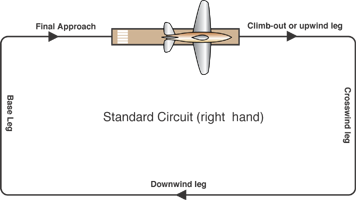Circuit (airfield)
|
|
At an airfield, the circuit is a conventional standard path for coordinating air traffic that is taking off and landing, as opposed to a practice of so-called "straight in approaches" and "direct climb outs". It is usually employed at small general aviation (GA) airfields, though it is also used at military airfields. Most large airports don't use this system as such, unless they have GA activity as well as commercial flights. However, a circuit of sorts is used at airports in some cases, such as when an aircraft is required to go around.
Circuits can be defined as left or right hand, according to which way the turns in the circuit lie. Circuits are typically rectangular in basic shape, and include the runway along one long side of the rectangle. Each leg of the circuit has a particular name:
- The section extending from the runway ahead is called the climb out or upwind leg.
- The first short side is called the crosswind leg
- The long side parallel to the runway but flown in the opposite direction is called the downwind leg
- The short side ahead of the runway is called the base leg
- The section from the end of base leg to the start of the runway is called the final approach or finals.
- The area of the airfield adjacent to the runway but opposite the circuit is known as the dead side.
An aircraft taking off will usually be expected to follow the circuit in use, and one arriving at the field to land will be expected to join the circuit in an orderly fashion before landing. This is often accomplished using an overhead join, or by entering on any of the circuit legs, traffic permitting. Aircraft are expected to join and leave the circuit in an orderly and safe manner. Sometimes this will be at the discretion of the pilot, at other times he will be directed by air traffic control. Airfield operators will set up circuits according to the runway in use, the local conventions for noise abatement or other ground features, and the current usage of the airfield. While many operate a completely standard pattern, in many cases it will be modified according to need. For example, military airfields often dispense with the crosswind and base legs, but rather fly these as circular arcs directly joining the upwind and downwind sections.
TrafficPattern.png
An airfield will define a circuit height, that is, a nominal altitude above the field (see QFE) that pilots are required to fly at while in the circuit. Unless otherwise specified, the standard circuit height is 1000ft AGL.
The use of a circuit at airfields is for safety - rather than have aircraft flying around the field in a haphazard fashion, by using a circuit pilots will know where to expect other air traffic from, and be able to see it and avoid it. GA pilots flying under VFR conditions will not be separated by air traffic control, and so the circuit is a vital way to keep things orderly.
A pilot undergoing training will often fly many, many circuits one after another. Usually, each landing is followed immediately by a take off and further circuit. This is called a touch and go.
Americans usually refer to the circuit as the traffic pattern or simply pattern. Similarly, circuit height would be referred to as pattern altitude.

